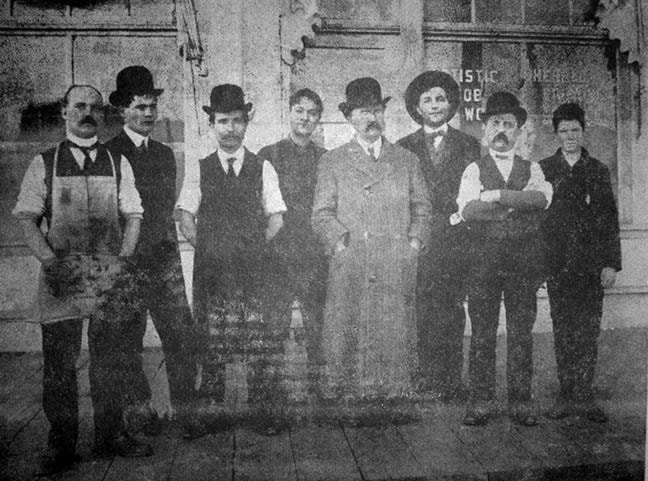The Little Paper Printed Where You Used To Live
‘Tisn’t filled with cuts and pictures nor the latest news despatches;
And the paper’s often dampened and the print is sometimes blurred.
There is only one edition, and the eye quite often catches
Traces of a missing letter, and at times a misspelled word.
No cablegrams nor specials anywhere the battle rages
The makeup is mayhaps a trifle crude and primitive.
But an atmosphere of home-life fills and permeates the pages
Of the little country paper, printed where you used to live...
You can see the old home village, once again in fancy;
Seeming to be clasping hand or neighbor and of friend and relative;
And their faces rise before you as you’re idly dreaming,
O’er the little country paper printed where you used to live.
Author Unknown, Herald Newspaper 1907
JIM CAMERON
Ah yes, the little country paper; aside from letters, telegraph and traveller’s tales, the local paper was the sole source of news for most residents. There were out-of-town newspapers, of course – the CPR brought them in on a regular basis – but the local paper, while often ignoring the larger picture, served up the local news. In 115 years Cranbrook has never been without a regular weekly paper and for many years the city has been graced by a daily newspaper publishing up to 25,000 copies weekly and employing 25 office staff alone, a far cry from the little country paper of yore.
How different then is the present day paper from that of its earliest predecessor, the Cranbrook Herald? In the most basic of ways it is not different at all: the news is gathered, printed, folded and delivered to the public. Nonetheless, let us take, as an example, a copy of the Cranbrook Herald from June 1911. Newspapers were bigger then. Not necessarily in length, but in actual size. The 1911 Herald was a broadsheet, typically twice the size of the present day tabloids. It was generally eight pages in length although that varied year to year and occasionally week to week depending on the amount of available paper and other considerations such as short-staffing, mechanical breakdowns and the occasional fire. The size of the paper allowed for at least seven columns of type per page which, over the course of eight pages, made for a substantial amount of reading.
Typographical errors were ont uncommno along with udsipe-pown letters and sdrawkcab words, more so it seems following local celebrations when the men of the press room may not have been at their best.
On the other hand, if an advertisement was printed upside down it was generally assumed to indicate that the business in question had failed to pay the bill. Pleas for payment from subscribers appeared on a fairly regular basis, as for example: “It takes wind to run a newspaper. It takes a scintillating acrobatic imagination and a railway pass to run a newspaper. But money – heavens to Betsy and six hands round, who ever needed money to run a newspaper? Kind words are the medium of exchange that does the business for the editor, kind words and church social tickets. When you see an editor with money, watch him. He will be paying bills and disgrace the profession. Make him trade it out. He lives to swap. Then when you die, after having stood around and sneered at his Jim Crow paper, be sure and have your wife send in for three extra papers and when she reads the generous and touching notices about you, forewarn her to neglect to send 15 cents to the editor. What the editor wants is heartfelt thanks. Then he can thank the printers and they can thank the grocers.”
Full page headlines were rare; the Herald of June 8, 1911 ran small headlines over sixteen articles on page one, almost all local in nature although on occasion the first page was entirely taken up by a single story, the death of an English monarch for instance. Photographs were not entirely uncommon although local photos were used sparingly at best and rarely on the first page. The second page was devoted to provincial/federal politics, land notices, and statistics. Page three contained news of the district: Elko, Fernie, Bull River Falls, Moyie, Baynes Lake et al. Page four was home to editorial views on both local and national affairs, often political or moral in nature, adages and general words of advice or humour along with a church column, upcoming community events, local news items and want ads. Page five contained numerous local notes (about one hundred and five items in this case). Page six covered news form the Columbia-Kootenay Valley and numerous lodge notices while page seven boasted a half page (with photos) of an upcoming visiting theatrical production. The remainder featured “Old Country News” (primarily England) and various notices. Page eight returned to local notes. There was no sports page, no weather, no cartoons, no crossword or word games, no classified page, no women’s page and no entertainment page. There were, however, advertisements on every page. Then, as now, advertisers made up a great deal of the income. In short: back then more writing, today more pictures; back then bigger, today smaller; back then a little country paper reporting local news, today a bigger city paper reporting local news.
One thing certainly remains the same, however: when you see an editor with money, watch him.
